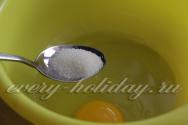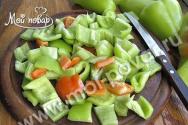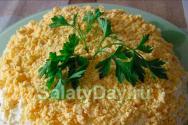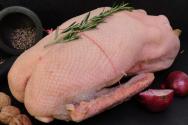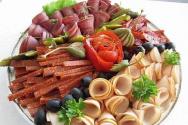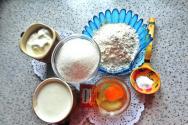Dolma (in grape leaves). Dolma in grape leaves, step-by-step recipe with photos How to cook grape leaves
Variety of grape leaves, use in cooking. Calorie content, benefits and harms when consumed. What foods and drinks can you prepare? Interesting Facts about grape leaves.
The content of the article:
Grape leaves (lat. Vitis vinifera) are a product that is collected from a cultivated plant (perennial shrub vine) of the same family and species, widely used in national cuisines. The shape of the leaf blades depends on the crop variety. They can be large or small, with 4-7 veins extending from the petioles. The design of the edge also differs: openwork, jagged, smooth. The leaves are palm-shaped with lobed fingers or whole, elongated. The lower side is often covered with a delicate pile - the edge, the upper side is striking in variety and depends on the variety. There are plants with wrinkled, smooth and shiny leaves, with edges bent down or curved up. The functions of grape leaves: accumulation of organic substances, feeding the plant with oxygen and evaporation of water. Under the influence of ultraviolet radiation, starch and mineral salts are formed, which give the product a characteristic sweet and sour spicy taste. In the Caucasus, Greece, Turkey, France, Vietnam, China and Italy, the taste and beneficial features culinary ingredient.
Composition and calorie content of grape leaves

Many people believe that the nutritional value of the product is low, so they can safely replace cabbage or lettuce in a diet for weight loss.
Calorie content of grape leaves is 93 kcal per 100 g, of which:
- Proteins - 5.6 g;
- Fats - 2.12 g;
- Carbohydrates - 17.31 g;
- Dietary fiber - 11 g;
- Water - 73.32 g;
- Ash - 1.65 g.
- Vitamin A, RE - 1376 mcg;
- Alpha Carotene - 629 mcg;
- Beta Carotene - 16.194 mg;
- Beta Cryptoxanthin - 9 mcg;
- Lutein + Zeaxanthin - 1747 mcg;
- Vitamin B1, thiamine - 0.04 mg;
- Vitamin B2, riboflavin - 0.354 mg;
- Vitamin B4, choline - 12.8 mg;
- Vitamin B5, pantothenic acid - 0.231 mg;
- Vitamin B6, pyridoxine - 0.4 mg;
- Vitamin B9, folate - 83 mcg;
- Vitamin C, ascorbic acid - 11.1 mg;
- Vitamin E, alpha tocopherol, TE - 2 mg;
- Vitamin K, phylloquinone - 108.6 mcg;
- Vitamin RR, NE - 2.362 mg.
- Potassium, K - 272 mg;
- Calcium, Ca - 363 mg;
- Magnesium, Mg - 95 mg;
- Sodium, Na - 9 mg;
- Phosphorus, P - 91 mg.
- Iron, Fe - 2.63 mg;
- Manganese, Mn - 2.855 mg;
- Copper, Cu - 415 μg;
- Selenium, Se - 0.9 μg;
- Zinc, Zn - 0.67 mg.
Sterols per 100 g:
- Phytosterols - 21 g;
- Stigmasterol - 2 mg;
- Beta Sitosterol - 20 mg.
- Omega-3 - 0.856 g;
- Omega-6 - 0.148 g;
- Saturated - 0.336 g, most of all palmitic;
- Monounsaturated - 0.081 g, oleic predominates;
- Polyunsaturated - 1.065 g, of which linolenic - 0.856 g, linoleic - 0.148 g.
Beneficial properties of grape leaves

Traditional medicine uses almost all parts of the plant, including tendrils, bark and young shoots, to make medicinal compositions.
Benefits of grape leaves:
- They improve the condition of the intestines, prevent constipation, cleanse and help get rid of the accumulation of toxins.
- Promote weight loss: fill the stomach and create a feeling of fullness, allowing you to increase the gap between meals.
- Antioxidant effect - isolate free radicals circulating in the bloodstream. They stimulate the production of resveratrol, which reduces the risk of stroke and heart attack.
- Improve visual function and prevent aging of the optic nerve.
- Accelerate liver cleansing and help recover from infectious processes in the digestive organs.
- Antimicrobial effect, most pronounced in relation to fungal flora. Women use decoctions of the leaves to treat thrush.
- They help get rid of complications of viral and colds - sore throat, bronchitis, pharyngitis and laryngitis.
- They help lead to long-term remission of varicose veins and relieve pain.
- Eliminate pain from migraines, radiculitis and gout, burning in the eyes.
- They destroy urate stones in the kidneys and have a mild diuretic effect.
- In case of uterine bleeding, reduce the amount of discharge.
- Normalize blood sugar levels.
- Eliminate tachycardia, calm, relieve nervous tension, and prevent the development of depression.
- Syrup from grape leaves has antipyretic properties.
Grape leaves are especially useful for men. They eliminate the effects of a hangover, have a positive effect on potency, increase libido, prevent the formation of prostate adenoma and improve sperm quality. Is it not thanks to this addition to the diet that many legends about “hot” men of Spain, Italy and the Caucasus were formed?
Contraindications and harm of grape leaves

Not everyone and not always can diversify their diet with new dishes.
There are many contraindications to the use of grape leaves:
- Increased acidity of gastric juice, causing frequent heartburn;
- Peptic ulcer and erosive gastritis;
- Diabetes mellitus in the acute stage;
- Heart and kidney failure;
- Urolithiasis and cholelithiasis;
- Bronchial asthma and complications of colds.
Recipes for dishes with grape leaves

The product is eaten raw, boiled, pickled, salted. It is stewed, steamed, and fried. How to prepare a grape leaf, everyone decides independently, depending on their own taste and preferences.
You can even go up to the vine, pick the freshest leaf and chew it. There will be no harm to the body. But don’t get carried away with conservation. Fresh grape leaves contain enough acids and sodium, while pickled and salted leaves increase the amount of these substances.
Before preparing national cuisine, you need to learn how to choose the right leaves. Preference should be given to green grape varieties - their leaf blades are soft, shiny, without raised edges.
Recipes with grape leaves:
- Suluguni. Suluguni cheese 0.5 kg is cut into thin slices and wrapped in leaves. One is missing, two are used. Mix 100 g of buckwheat honey with 2-3 cloves of crushed garlic and paprika. Fry the wrapped cheese in a hot frying pan in a mixture of oils - butter and vegetable. Serve hot, smeared with spicy honey sauce.
- . Collect fresh large leaves and remove the hard part. You can slightly flatten the veins with a wooden masher, but be careful not to break the plate. Place the water on the fire and lower the sheets there. Boil until the color darkens. Then put it in a colander to drain the water. You can try to blanch the leaves, but there is a high chance that they will become wrinkled and tear. The onion is grated on a fine grater, the meat is turned through a meat grinder. You should not use a blender; hard streaks and films will remain. The proportions of meat and onions are 3:1. The rice is boiled until completely cooked. Mix meat, onion and rice, add salt and pepper. Wrap the minced meat in grape leaves, starting from the stem part. Place in a saucepan in a thick layer, simmer over low heat under the lid until the meat is completely cooked.
- Casserole. One medium-sized zucchini, 100 g, is grated on a fine grater hard cheese. Chop the greens - cilantro and parsley, add 3 eggs, 200 g of cottage cheese and 6 tablespoons of flour. Add salt and knead soft dough. From chicken meat making meatballs, grinding them into minced meat with onions. Salt to taste. Place a thick layer of grape leaves on a baking sheet, a layer of dough on top, and small meatballs as a third layer. Preheat the oven to 200°C and bake for 40 minutes. 15 minutes before the end of baking, remove the tray and sprinkle the casserole with grated cheese. The dish is served warm, with sour cream.
- Preparation for the winter. Most of the nutrients are preserved if the leaves are frozen. To do this, collect intact plates, without tears, with a whole juicy elastic cutting. Stack one on top of the other, compact it, roll it into strong rolls and wrap it in cling film. In this form they are placed in the freezer. If you wash the greens first, you need to dry them thoroughly. There are other methods of preparation: dolma is made from canned grape leaves, they are included as ingredients in salads, but freezing is preferable - all the beneficial substances that are destroyed during heat treatment are preserved. To defrost, the leaves are dipped first in cold water, then in warm water.
- Cabbage salad. Chop 200 g of leaves white cabbage, cut grape leaves into thin strips to make 4 tablespoons. On coarse grater grate green apples - 4 pieces, crush 4 cloves of garlic, chop 2 tablespoons walnuts. All ingredients are mixed. The salad is dressed with homemade yogurt or unsweetened yogurt, and added salt to taste.
- Conservation. Knowing how to pickle grape leaves, you can prepare dolma all year round. Tear off the leaf blades along with the cuttings, wash them, and lay them out on a paper towel to remove excess moisture. The dried leaves are rolled up. The jars are sterilized, 4-5 black peppercorns and 2 allspice, 2 clove buds, 3 bay leaves are placed on the bottom of each. The volume of the jars is no more than 0.5 liters, since the sheet rolls should be placed vertically, filling the jar without gaps. Fill the container with boiling water, cover with lids, and leave for 8 minutes. Drain the water into enamel pan, put it on the fire, add salt without iodine and sugar in equal quantities. When all the spices are completely dissolved, pour in 9% vinegar and turn it off immediately. For 1 liter of water - 1 tablespoon each of salt and sugar, 2 - vinegar. Pour boiling marinade over the rolled leaves, cover with lids and place in a wide pan of boiling water to sterilize. The lids that will be rolled up are sterilized separately. After 15 minutes, the jars are closed, turned over and left to cool under a blanket. Best stored in the refrigerator.
- Stuffed cabbage rolls in grape leaves with lamb. The meat is cleaned of films, the pickled grape leaves are poured with cold water to remove the taste of spices and excess salt. Lamb and a piece of fat tail are turned with onions, raw washed bulgur and spices of your choice are added to the minced meat. If the minced meat is thick, dilute with boiled water to the desired consistency. The leaves are washed, lightly dried with a towel, and laid face down. Stuffed cabbage rolls are formed. Place in several layers in a pan according to the following principle: the first layer is leaves, the second is dolma, and so on. Cover the top with a plate, like a weight, pour in slightly salted water, and cook for 30-40 minutes. Melt in a frying pan butter, remove the foam from the surface, fry the shredded mixture of mint leaves and onions. There should be enough oil so that it does not evaporate. As soon as the onion becomes soft, remove the pan from the heat and thoroughly whisk the contents. Dolma is served with mint sauce.
Recipes for drinks made from grape leaves

Teas, alcoholic drinks and decoctions of grape leaves quench thirst, tone, and help recover after physical exertion.
Drink Recipes:
- Infusion. Dissolve sugar in water in the proportion of 2.5 liters of liquid per 1 glass. Fill the jar tightly with fresh leaves with short-cut cuttings, approximately halfway. They insist for at least a day. The longer it sits, the richer the taste. Reminds me a little of birch sap.
- Tea. Mix a tablespoon of green tea, 3 chopped green grape leaves and 5 crushed berries. Pour a glass of boiling water, leave for 5 minutes, double the amount of liquid, and leave again. Honey and mint are added to improve the taste.
- Wine. Pour 7 liters of water into a large enamel pan and bring to a boil. Turn off, fill 1/3 with grape leaves. The layer should be dense. In order to compact, use a wooden masher. The container is wrapped in a “soldier’s” blanket and put away for 3 days. No need to shake. The sour brown wort is drained, mixed with half a glass of granulated sugar and 2 handfuls of seedless raisins. Ammonia is also poured in there: for every 10 liters - 3 g. They are left to ferment, covering the neck of the container with gauze, constantly checking the taste. It should be sweet. Sugar is added as needed. Intensive fermentation ends when the darkened head of foam subsides. Pour the drink into plastic bottles, leaving them a third full. Passive fermentation continues, if you ignore the recommendation, the bottle will burst. Gas is released as needed. As soon as passive fermentation ends, the wine is poured into clean glass bottles. Store in a cool place.

Grape leaves gained popularity much earlier than berries. On the first vines they were small, sour, and almost not used for food. But already in Ancient Greece and Rome the vine was called “paradise” because of the berries - it was already bred the sweetest varieties.
Interestingly, historians and archaeologists are still debating the origin of the grapevine. The Bible says that Noah was the first to plant the plant on Mount Ararat. And if you believe the results of excavations, then fragments of whips and leaves were found in the cultural layer in the territory of modern Turkey and Iran.
The amount of sugars and the content of nutrients in the leaf blades depends on the grape variety. If the berries are red and black, the nutrients include beta-carotene, sweet ones - more starchy substances, green sour ones - the amount of citric and acetic acid increases.
Watch the video about grape leaves:
If the goal is not just to diversify daily diet, and to improve your health, you should prepare young spring leaves for the winter, collected before the vine blooms. Thanks to such foresight, during the epidemic season it will be possible to save on antiviral and anti-inflammatory drugs.

Dolma (tolma, sarma) is a dish consisting of stuffed vegetables or leaves (usually grape), cabbage rolls in grape leaves. The filling is usually prepared on the basis of rice; it may also contain boiled chopped meat, but can also be vegetarian. Dolma is widespread in the cuisines of the peoples of the former Ottoman Empire, the Russian Empire, the Balkan Peninsula, Central and South Asia: Azerbaijan, Albania, Algeria, Armenia, Greece, Georgia, Egypt, Iraq, Iran, Jordan, Lebanon, Palestine, Syria, Northern Sudan, Turkey, Uzbekistan.
Origin of the dish and name The variant name “dolma” is common to several Turkic languages (Turkish dolma, Azerbaijani dolma, Crimean dolma, Turkic dolma) and, according to a number of sources, comes from the Turkic verb dolmak (Turkish dolmak) with the meaning “ fill". According to amateur cook, author of cookbooks Stalik Khankishiev: ... originally this name arose among the Turkic peoples of Central Asia and applied to any minced meat dish with filling inside. For dishes involving wrapping meat filling leaves, there is also a traditional name sarma (from the Turkic verb sarmak meaning “to wrap”).
The Armenian name “tolma” (Armenian: տոլմա) is associated with տոլի (toli), meaning “grape leaves”. According to a historian, author of books on cooking and history national dishes William Pokhlebkin, the dish itself originated initially in Armenian cuisine: From the 17th to the beginning of the 19th century. Armenia was divided between Turkey and Iran. During this period, the economy of Armenia, its human and material resources fell into decay, but the spiritual and material culture did not change, and the Armenian cuisine did not perish.
On the contrary, the Armenians contributed to the cuisine of the Seljuk Turks, so that many truly Armenian dishes later became known in Europe through the Turks as supposed dishes Turkish cuisine(for example, dolma). Agree when it comes to creating a menu for festive table, many of you have to think very deeply about choosing a hot dish. I want to cook something special that will be non-trivial and that can surprise guests.
Such a “highlight” of the festive table can be a traditional oriental dish - dolma in grape leaves! Where can I get grape leaves? The first question that concerns us is: where to get grape leaves? It is unlikely that you have a grapevine growing under your window (like mine), and you can always pick fresh young leaves. It should also be noted that if you are preparing dolma from fresh grape leaves, then you will need to first rinse them, and then pour boiling water over them and leave for 3-4 minutes. I boil for about 5 minutes, for the taste of our family it is not enough just to soak the leaves in boiling water. If the fresh version of the leaves is not available, then you can buy salted leaves.
If you bought this option for your dolma, then before using the leaves, fill them with plenty of warm water and leave them overnight - this will remove excess salt. In addition, each sheet will need to be thoroughly washed before cooking. And do not forget that the leaves are already salted, so at the final stage of preparing dolma - boiling - it is worth taking this fact into account.
If you couldn't find either fresh or salted leaves, then you can buy canned leaves at the supermarket. Whatever option you purchase for dolma, in any case, before cooking you need to cut off the cuttings of each leaf. Ideally, of course, dolma is made from lamb. But there are also deviations from ideals! I am already offering a “European version of dolma”
In Greece - Cypriot dolmades (vegetables and rice in grape leaves), in the Caucasus countries - meat, fish, vegetables, rice, millet, wrapped in not only grape leaves, but also quince and fig leaves. In addition, tomatoes, peppers, and eggplants are stuffed with minced meat. Each National cuisine uses certain spices, seasonings, herbs. Georgian dolma is very hot and spicy, as Georgians add red pepper, tarragon, garlic, and cilantro to it. In Armenia, dried or fresh mint is added to the rice and meat filling. In Greece they put it in abundance lemon juice And olive oil. In countries where dolma is a popular dish, grape leaves are even prepared for the winter, and therefore dolma is eaten all year round. However, you can buy such “pickling” from grape leaves in Russia.
Benefits of dolma
About dolma we can say with complete confidence that it really is healthy dish. Minced grape leaves cannot be boiled or fried, retaining most of the beneficial substances during stewing. If you are watching your diet, KhozOboz recommends that you do not get carried away with spices and use lean beef, pork or chicken. During cooking, the grape leaves release essential oils and tannins, which not only impart an extraordinary taste and aroma, but also have a moderate bactericidal effect.
KhozOboz advises you to use only tender young leaves, which have more beneficial properties. Never eat raw leaves, even for salads. The herbs used in the filling go well with meat and rice, give a great taste, and contain many vitamins and microelements.
We will have dolma, the recipe of which consists of the most accessible and familiar products for most Russians. To prepare 2 servings you will need the following ingredients:
- Grape leaves - according to the number of “dolmushki” you plan to prepare. The leaves should be young, not too different, and medium in size. Take the required amount with a small margin.
- Minced lamb, pork or beef – 0.5 kg. You can use a mixture of several types of meat.
- Rice – 100 grams.
- Onion – 2 onions. We will also use young onions.
- Garlic – 2 cloves.
- Herbs (dill, basil, cilantro) – 20 grams.
- Water – 200 grams.
- Special spices for dolma, it is better to buy oriental ones at the market. In the absence of these, we use suneli hops.
- Salt - to taste.
Cooking process
- Boil the rice in a small amount of salted water until half cooked for 15 minutes.

- Scald the grape leaves with boiling water. The leaves should darken.

- At this time, finely chop the onion.

- Chop the greens.

- If you have young onions, use them too, after chopping them.

- Prepare the filling: mix rice, minced meat, herbs, onions, salt, spices.

- Line the bottom of the pan with leaves. This cunning move will help you avoid the food from burning.
- We form “envelopes” in several stages, lay out the scalded leaf;

- Place a dessert spoon of minced meat on the leaf;

- Cover the filling with one side of the side of the leaf;

- Then another;

- We bend the remaining part of the “envelope” to the bottom.

- Carefully place the “dolmus” into the pan.

- All “envelopes” should be pressed tightly against each other. If there is a lot of dolma, it can be laid out in several layers.

The “envelopes” need to be laid out tightly to each other, or in several layers
- We pour water according to the level of our products and put garlic there.

- Cover the dolma with a plate. – KhozOboz gives this recommendation to ensure that the “envelopes” do not disband. Place on fire for 30-40 minutes.

We press our “layout” with a plate, as if to fix it
- Place the finished dish on a plate.

- You can serve this queen of oriental cuisine with vegetables and red wine, or with kefir and garlic sauce.


Fold the edges to the center of the “roll”
Cooking options
As already mentioned, there are many options for preparing this dish. KhozOboz advises you to try using a few sprigs of mint in minced meat and rice, which you need to chop finely. You can also make this dish like our cabbage rolls, using frying from tomato paste, carrots and onions. The main thing here is not to interrupt the delicate aroma of grape leaves. The filling will acquire a richer and brighter taste if you add finely chopped tomatoes and peppers to it.
Remember that the menu of our cuisine should not be limited to pasta, cutlets and mashed potatoes. Sometimes unusual (and healthy!) ingredients for exotic dishes grow right in our garden, but we don’t know about it.
Many people still cannot understand the full strength and power of nature, while others are already trying with all their might to extract the maximum from its gifts. Some can calmly pass by grape leaves and not even think about how widely they are used in a variety of areas, while others try to can and freeze them. Such a simple ingredient can completely change the taste of a dish, turning boring food into an exquisite and unusual dish. But not everything is so simple with this addition. You can learn about the benefits and harms of grape leaves, the rules for their use and interesting recipes in the article below.
The value of grape leaves
Grape leaves are just the case when a real treasure is just under our noses. For the first time, folk doctors started talking about this plant as a preventive remedy for many diseases. The benefits and harms of grape leaves come from the microelements that are in their composition. So what is so valuable about this simple, but, as it turns out, rich product? Firstly, these are fatty acids. Grape leaves are an excellent source of Omega-3, which reduces the risk of prostate, breast and colon cancer. This element is also a preventative against depression, arrhythmia and rheumatoid arthritis.
Secondly, grape leaves help stop the progression of Alzheimer's disease. This product prevents plaque buildup in the brain and memory loss. True, only some types of grapes have this property (for example, Amur grapes). Thirdly, these leaves have valuable anti-inflammatory properties, which is especially important in the modern environment. Fourthly, this ingredient contains many antioxidants. Among them is resveratrol, which actively fights heart disease, lowers cholesterol levels and normalizes blood clotting. And lastly, grape leaves help with chronic venous insufficiency. All this suggests that such seemingly ordinary things can turn out to be a panacea for many diseases, which means we need to be more attentive to the world around us.
Damage to grape leaves
Even foods rich in vitamins and beneficial microelements can be harmful to the body. The same applies to grape leaves. Some people need to be especially careful with this plant and consume it in moderation. These are those who have diabetes, stomach ulcers and obesity.

In this case, it is recommended to completely refuse the pleasure of tasting dishes using this ingredient, and if this is not possible, you should consult a doctor before such a meal. So before covering grape leaves for the winter, it is better to think about whether there are any contraindications to their use.
Grape leaves instead of going to the pharmacy
Knowing about the beneficial properties of grapes is one thing, but knowing how to use them is quite another. Fresh grape leaves can be a real miracle and help cope with many diseases in just a couple of days. And the big advantage is that even in canned or dried form, this product does not lose its properties, which means it can be used all year round. An infusion of dried grape leaves is often used for pharyngitis and laryngitis. It should be prepared in proportions of 1 cup of boiling water to 1 tablespoon of dry leaves.

If you drink half a glass three times a day, the disease will begin to recede and your condition will noticeably improve. You can prepare grape leaves by drying and grinding them. In addition, if you take 2 grams of this product every day, you can cope with uterine bleeding. Fresh leaves are perfect for skin diseases, cuts and wounds - just apply them as a compress.
Canned grape leaves
Skillful housewives have learned to preserve grape leaves. Since this product is used in the preparation of dolma, this way you can provide yourself with the opportunity to taste such a delicious dish at any time of the year. But before you put it in a jar, you should familiarize yourself with the benefits and harms of grape leaves. Their preparation will take approximately 1.5 hours. To do this you need 120 leaves themselves, 3-5 liters of water and a heaped tablespoon of salt. The first stage is sterilization of containers. It doesn’t matter which jars the leaves will be placed in. As a rule, 50-60 leaves are placed in half-liter ones, 70-80 in 750-gram ones, 120 in liter ones. Grape leaves need to be washed and dried. Since you need quite a lot of them, you won’t be able to do everything at once, so it is recommended to prepare them throughout the day.

It is best to cover the young branches, as they are soft and juicy. To prevent the leaves from being damaged, it is recommended not to put them in layers in a jar, but to twist them into tubes of 7-10 pieces. Next, you need to pour boiling water over them and leave for 40-45 minutes, then drain the water. Then you should add salt, pour boiling water again and roll up. Harvesting grape leaves does not take much effort and pleases with excellent results.
Classic dolma made from grape leaves
When it comes to recipes with grape leaves, dolma immediately comes to mind. This oriental dish has captivated many with its ease of preparation and rich taste. If it is possible to prepare it from fresh grape leaves, it is better to use it, but canned ones are also suitable. The second nuance is meat. Dolma is usually prepared from lamb, although many housewives make this dish just as incredibly tasty using pork, beef and even chicken. To create such a culinary masterpiece you will need 500 grams of minced meat, 100 grams rice cereal, 2 onions, 2 cloves of garlic, 200 ml of water, salt, grape leaves, herbs and spices.

The rice needs to be boiled until half cooked, the onion and herbs (parsley, dill, cilantro, basil) should be chopped - and all this should be added to the minced meat. Next, mix everything well, add salt and spices. The grape leaves should be washed and dipped in boiling water for 3-5 minutes to make them easier to roll later. If the leaves have darkened, it means they are ready to use. You need to put the prepared mixture in the middle and wrap it (first the lower edges, then the top). It is recommended to place a layer of grape leaves on the bottom of the pan, and then place the finished envelopes there. Fill with water, add garlic, cover with a lid, leave on medium heat for 30-40 minutes, and voila - delicious and aromatic dolma is ready to serve.
Dolma with red rice and barberry
You can add a few unusual ingredients to even the simplest dish and turn it into a real gastronomic delight. Dolma from grape leaves can be prepared according to the most interesting recipes, one of which is described below. For such a masterpiece you will need the same set of ingredients as for classic dolma, only you need to replace regular rice with brown rice and add sour cream and 3 tablespoons of dry barberry to the list.

This dish is prepared according to the same scheme: mix almost finished rice, minced meat, herbs, spices and barberries, prepare grape leaves and make envelopes (or tubes). Then you need to put them in a mold and add a filling of sour cream, seasonings, herbs and 100-200 ml of boiling water. For rich taste You can add more barberries and peppercorns on top. The last step is to put it in the oven, preheated to 170 degrees. 50-60 minutes of stewing - and the exotic dish is ready to eat.
Grape leaf tea
Grape leaves are prepared for the winter not only for preparing dolma, but also for tasty and healthy tea. To do this, you need to cut young leaves, wash them and let the water drain. For the next stage, drying vegetables is perfect, but if you don’t have one, you can do this in a regular oven.

The tea itself is incredibly simple to prepare: you need to pour boiling water over the dried leaves and let them brew for 5-10 minutes. To constantly spend winter evenings warming up with such a drink, you need to prepare large quantities of grape leaves in advance. It’s better to spend a couple of hours on this and enjoy tea all year long than to regret the missed opportunity.
Grape leaves in cosmetology
The benefits and harms of grape leaves can be the subject of debate, but this does not negate the fact that some substances in their composition make them an ingredient with an excellent anti-aging effect. Our grandmothers used them as a cosmetic product, which allowed them to always look great. This component can easily cope with spider veins on the skin. To do this, you just need to relax in a bath with the addition of grape leaves 2-3 times a week. An infusion of this plant will help get rid of cellulite. You just need to pour boiling water over 30-40 grams of leaves and drink throughout the day for two weeks. The same infusion will tighten and rejuvenate the skin of the face. You just need to soak cotton pads in it and wipe your skin 2-3 times a day. All this points to one thing - we need to start harvesting grape leaves as quickly as possible in order to make the most of their value.
Good health, dear owners and followers of a healthy lifestyle! Since spring, I have prepared a solid harvest of an unusual and valuable plant for future use. Grape leaves, benefits and harms of garden vine shoots, have been repeatedly reviewed in specialized publications.
In the cuisine of different nations, the green parts of the plant are used to prepare a dish reminiscent of our cabbage rolls. They are stewed, fried, boiled, simmered in oil, but they are not suitable for salad. I have a big one, I like to experiment, I’ll describe what happened. Along the way, I will share information that I myself learned from various sources.
Green medicine
Who would have thought that a storehouse of vitamins and valuable organic compounds grows right in the countryside! I selected elite varieties, but it turns out that ordinary grapes are more valuable. Its young shoots contain a lot of substances beneficial to the body:
- Easily digestible sugars of natural origin;
- Tannins;
- Antioxidant compounds, vitamins A, C, E;
- Salts of silicon, sodium, phosphorus, copper, iron.
IN folk medicine wine berry has found wide application. Dry raw materials are used to prepare infusions for sore throats and inflammatory diseases of the throat. I make a decoction according to the classic recipe: add a tablespoon of crushed dry raw materials to a glass of boiling water. I leave it in the thermos for 2 hours, after which I rinse as needed throughout the day. I try to carry out the procedures before meals so as not to “smear” the therapeutic effect of the product.
I read an article in the newspaper that dry crushed greenery powder is used for nosebleeds (it is inhaled) and purulent wounds. I admit, I didn’t dare to conduct such an experiment myself. For me, it’s safer to use a decoction. It has an antiseptic effect, but is milder. And experiments with inhaling powders will not lead to anything good!
Universal medicine

 Fresh young leaves treat coughs, improve potency in men, the juice helps with diseases of the gastrointestinal tract: stops vomiting, diarrhea, improves peristalsis. Contains fiber, which improves gastrointestinal motility and promotes rapid digestion of food.
Fresh young leaves treat coughs, improve potency in men, the juice helps with diseases of the gastrointestinal tract: stops vomiting, diarrhea, improves peristalsis. Contains fiber, which improves gastrointestinal motility and promotes rapid digestion of food.
The decoction is used for headaches and constipation; it has a weak diuretic effect and dissolves stones in the bladder. Insisted on cold water greens (300 grams per 3 liters of water, leave in a cool, dark place for 3 days), when consumed internally, improves vision and alleviates rheumatic pain.
When used externally, the infusion promotes hair growth, lightens freckles, improves complexion, and reduces warts.
The beneficial properties and contraindications for the use of herbal products are incomparable: grapes help everyone. Only in large quantities it should not be eaten by people who have:
- Diseases of the cardiovascular system;
- Stomach and duodenal ulcers;
- Diabetes.
Fortunately, I don’t suffer from any disease, so I eat natural and delicious product for your pleasure!
Cooking for future use

I know many people who lead a healthy lifestyle, collect medicinal herbs, and drink healthy foods instead of coffee. herbal teas. But when it comes to harvesting greens wine berry, they all plan to use raw materials to prepare Asian and Oriental dishes - cabbage rolls or dolma.
If you don’t know how to prepare grape leaves, use the advice of culinary experts. There are several ways to keep them practically fresh, ready for use and not subject to any additional processing.
- Sterilization of freshly harvested raw materials;
- Filling with marinade;
- Pickling;
- Freezing.
Regardless of which method you prefer, before harvesting you will have to adhere to certain rules so that beneficial properties and minerals are not lost over the winter.
Only young, tender green leaves are picked. Light colored ones are most suitable for culinary purposes. cultivars with a pleasant sweetish aftertaste. Pruning is done on a dry day, in the morning, to avoid dew drops that cause stains.
Preparation and storage

To prepare using the dry method, the sheet plates are tightly rolled one on top of the other, and the resulting rolls are placed in a sterilized glass jar. Then cover with a lid, sterilize for about an hour in the oven, roll up, and leave for storage in the basement. The advantages of the method are ease and low time consumption. With proper preparation in winter, you will have semi-finished products on hand that are close in properties to fresh grapes. Disadvantages – it is not always possible to maintain the processing technology.
In the North Caucasus, housewives harvest grape shoots for future use in a different way. They roll up bundles of 15-20 pieces at a time and pin them tightly with wooden skewers.
To preserve, the “rolls” are dipped one by one in boiling water for a few seconds, cooled in boiled water, packaged in jars, and filled with marinade (one and a half tablespoons of salt per liter of water).
After letting it brew for 2-3 days, pour a teaspoon on top apple cider vinegar(at least 9%). The resulting rolls should be completely covered with marinade. The jars are sterilized for 30 minutes in the oven. Canned leaves are pleasant to the taste and tender, and do not tear during cooking.
A few more ways
 Before freezing, the greens are washed under running water and spread on the table to dry. The packages are formed in the same way as for preservation. Dry rolls are placed in freezer bags and placed in freezer. Defrost carefully, thawing naturally, with room temperature– delicate “covers” are easily torn.
Before freezing, the greens are washed under running water and spread on the table to dry. The packages are formed in the same way as for preservation. Dry rolls are placed in freezer bags and placed in freezer. Defrost carefully, thawing naturally, with room temperature– delicate “covers” are easily torn.
If you don't have enough time, try salting the semi-finished product. Collected fresh leaves are washed, placed in jars, and filled with saturated cold saline solution (at least 10%). Be careful: The container is stored in the refrigerator, otherwise the contents will spoil.
Don't know how to pickle grape leaves? Take advantage simple recipe. The sorted greens are placed closely in an enamel pan, pressed down with pressure on top, then removed. Pour water to the top. The whole mass is brought to a boil, cooled, sorted, stacked, rolled, placed in jars, and marinade is poured.
To pour per liter of boiling water, add 2 tablespoons of salt and a few peas of allspice. The containers are sealed with polyethylene or metal lids. When the marinade has cooled, the jars are stored in the cellar or in the refrigerator.
What to cook

There are many specific dishes in the cuisine of the peoples of the world. I use semi-finished products prepared in the warm season to prepare dolma or cabbage rolls.
I'm retreating from classic recipe. I make dolma not from lamb, but from minced meat, which is in the refrigerator. Sometimes I add more herbs or spices to the filling. I like the combination of sour grape flavor and aromatic parsley and cilantro. As a sauce I use sour cream, mayonnaise, ketchup - depending on my mood. In any case, it turns out very well.
Despite the simplicity of preparing the dish, skill in rolling cabbage rolls is required. Especially if you use a canned or frozen product. Some housewives, in order to make the “cover” stronger, prepare old, large and dense leaves. It is not right! They are tougher, with pronounced veins, and bitter.
Here is a video recipe for making dolma from grape leaves
To gain skill, practice in advance on fresh preparations. Don't be afraid of cooking: a couple of unsuccessful attempts, and then everything will work out! In my family, cabbage rolls in any version are a familiar and favorite dish.
That's all, dear readers. I would be grateful for feedback in the comments and activity on social networks.
Do you use grape leaves for treatment? What dishes do you cook? What do you think is tastier - traditional cabbage rolls or grape dolma? What is easier for you to cook? Do the first and second cases require special skills? Do you prepare the green “shell” yourself or buy it ready-made? See you soon, always happy to chat!
